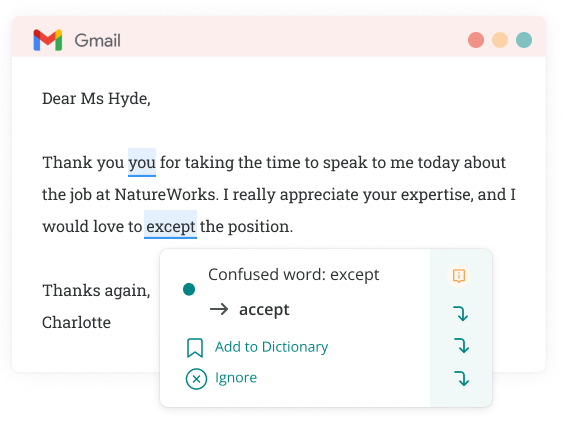
We all know that the English vowels are A, E, I, O, and U, but it might be hard to understand exactly why this concept is so important.
So what exactly makes a letter a vowel?
The short answer is that vowels are speech sounds that you can pronounce without restricting the flow of air from the lungs.
This article will explain how vowels work and why they’re so important.
What Is a Vowel?
Vowel Definition
According to the Merriam-Webster Dictionary, a vowel is a speech sound made with your mouth open and your tongue in the middle of your mouth, not touching your teeth or lips.
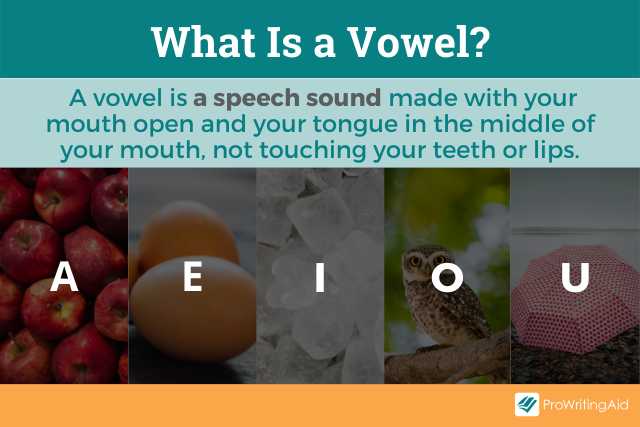
Vowel Meaning
A vowel is a speech sound made without a significant constriction of the flow of air from the lungs.
Every vowel sound is made by shaping the mouth in a specific way without blocking the airflow. You can create unique sounds by placing your tongue in various different positions (front, central, or back) and at various heights (high, mid, or low). You can also change the shape of your lips (rounded, neutral, or spread).
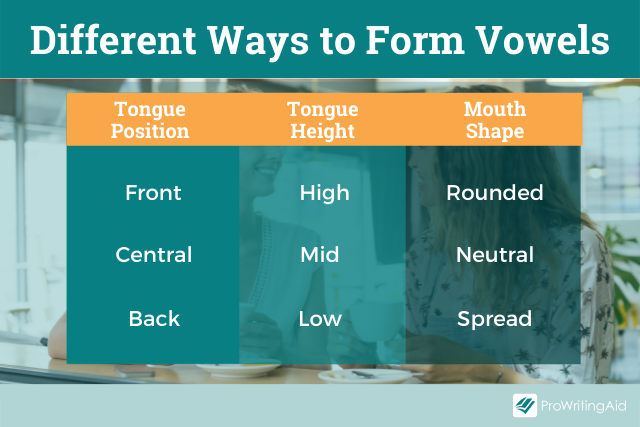
One way to help understand this concept is by opening your mouth and saying “ahh.” Now try changing the shape of your mouth without blocking the flow of air. If you stretch your mouth wider into a spread shape, you make more of an “e” sound. If you round your lips, you make more of an “o” sound. When you change the position of your tongue, those sounds change as well. Congratulations—you’re making different vowels!
As soon as you restrict or close your airflow, you start making a consonant. For example, if you bring your lips together you create a consonant such as “b” or “p.” If you touch your tongue to the top of your mouth, you create a consonant such as “k” or “g.” If you put your tongue between your teeth, you make a sound like “th.”
Blocking the airflow is the difference between a vowel and a consonant.
Vowel Letters
The English language includes six vowel letters: A, E, I, O, U, and sometimes Y.
The letter Y is only sometimes a vowel because it can be pronounced as a consonant (such as in the words “yellow,” “yam,” and “kayak”) and sometimes as a vowel (such as in the words “sky,” “thyme,” and “lovely”).
It’s a consonant when it involves blocking the airflow out of your mouth, and it’s a vowel when it doesn’t.
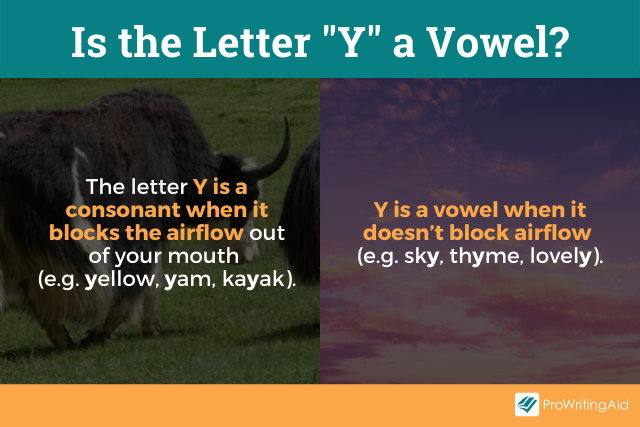
Here are some examples of vowel letters in common English words:
- Unit: the vowel letters are “u” and “i”
- Chocolate: the vowel letters are “o,” “o,” “a,” and “e”
- Rainy: the vowel letters are “a,” “i,” and “y”
Vowel Sounds
Even though we only have five vowel letters in English (A, E, I, O, U, and sometimes Y), we actually have a lot more than five vowel sounds.
Each vowel letter can be used to express more than one sound. For example, the letter “a” can be pronounced like the “a” in “rate” or like the “a” in “rat.”
Furthermore, we can represent vowels by combining the five vowel letters in different ways. Sometimes we combine two vowels together to make a specific sound, such as “ai” and “au.” Other times, we combine a vowel with a consonant, such as “ah” and “an.”
Here are some examples of vowel sounds in English words. Notice how they’re different from the vowel letters themselves.
- Unit: the vowel sounds are created by “u” and “i”
- Chocolate: the vowel sounds are created by “o”, “o”, and “a.” The “e” at the end is silent
- Rainy: the vowel sounds are created by “ai” and “y”
Why Are Vowels so Important in English?
Vowels are a crucial part of our language. Without them, we wouldn’t be able to speak or sing.
They’re also important for learning how to read and write English. Every beginner reader needs to learn vowels in order to sound out written words, since each syllable contains a vowel sound.
Let’s look more closely at the reasons why vowels are so important.
You Need Vowels to Cry, Laugh, and Sing
The human mouth is designed to include vowels in our speech sounds. We create vowel sounds even when we laugh or cry, regardless of the native language we speak.
We also need vowels to sing. Try singing a consonant sound like “k” or “t” or “b.”
You’ll quickly find that it’s impossible to sing a consonant without using a vowel. For example, you can sing the sound “kay” or the sound “tee,” but that’s because you’re singing the vowel sounds “ay” and “ee.” The consonants “k” and “t” only last for a moment.
If you pay attention to professional singers you’ll notice that they often draw out the vowel sounds, ending on consonants only at the very end. Unless you’re humming, you need to use vowels to sustain a sound for a long time.
Every Word and Syllable Needs a Vowel
Every syllable in the English language contains a vowel sound.
If you want to figure out how many syllables there are in a word, an easy method is to count the number of vowel sounds there are.
For example, say the word “tomato.” It has three syllables: to-ma-to. Here, the vowel sounds are “o,” “a,” and “o.”
Or say the word “counted.” It has two syllables: coun-ted. Here, the vowel sounds are “ou” and “e.”
You can have words and syllables without consonants, such as “I” or “oh”, but you can’t have a word without vowels. In a way, vowels are the heart of language—they’re the most basic component of the way we speak.
You Need Vowels to Create Assonance
Assonance is a literary device that involves the repetition of vowel sounds within nearby words. This device creates rhythm and helps writing to flow in a more musical way.
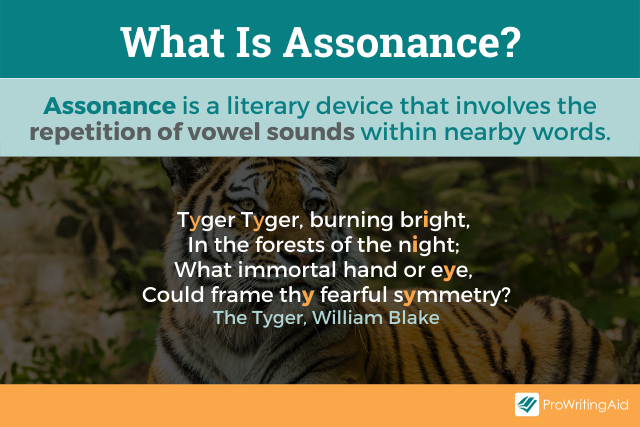
For example, consider this famous line from William Blake’s “Tyger”: “Tyger, Tyger burning bright in the forest of the night.” Here, the long “i” sound is repeated over and over. You hear it in “tyger,” “bright,” and “night.”
Another example is from the movie My Fair Lady: “The rain in Spain stays mainly in the plain.” Here, the long “a” sound is repeated over and over in “rain,” “Spain,” “stays,” “mainly,” and “plain.”
If you’re writing or reading poetry, you should pay attention to vowel sounds. You can make your poem more musical by using similar sounds in interesting patterns.
Origins of the Word Vowel
The word “vowel” originates from the Latin word “vox,” which means “voice.”
In contrast, the word “consonant” originates from the Latin words for “with sound”: con (“with”) and sonare (“to sound”).
The Difference Between Short & Long Vowels
There are two types of vowel sounds: long vowels and short vowels.
The names of vowels are long vowel sounds. Think of the way you pronounce the letters A, E, I, O, and U when you’re singing the alphabet song. These are long vowels.
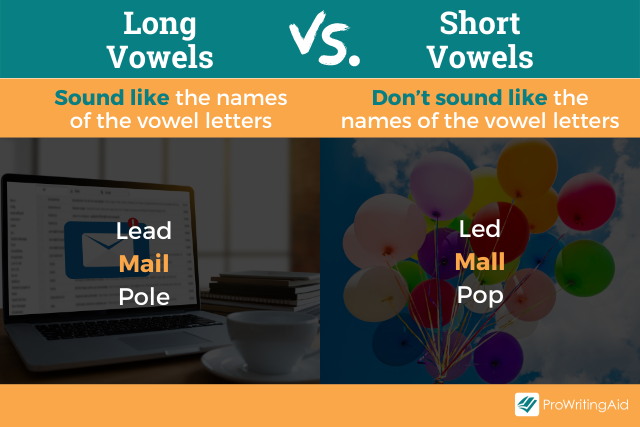
Here are some examples of long vowels in words:
- The “e” in “lead”
- The “a” in “mail”
- The “o” in “pole”
Whenever a vowel isn’t pronounced the way its name sounds, that means it’s a short vowel sound.
Here are some examples of short vowels in words:
- The “e” in “led”
- The “a” in “ball”
- The “o” in “pop”
It’s important to understand the difference between long and short vowels when you’re reading so you can pronounce the words correctly.
Long vowel sounds are often created by ending the word with a silent “e.” For example, the “a” in “hate” is a long vowel, while the “a” in “hat” is not.
Other times, long vowel sounds can be created by placing two vowels next to each other. For example, the “e” in “beat” is a long vowel, while the “e” in “bet” is not.
When a vowel appears by itself, it’s often pronounced as a short vowel, though this isn’t always the case. Practicing reading and pronouncing various English words is the best way to gain an intuitive understanding of how to pronounce each vowel.
Do Vowels Exist in Other Languages?
Every language has vowels, though some languages have more than others. For example, Japanese has only five vowel sounds, while Danish has 32.
Which words do you think have the strangest vowel pronunciations? Let us know in the comments.
Ready to Improve Your Writing? Try ProWritingAid.
